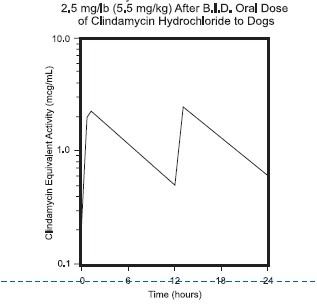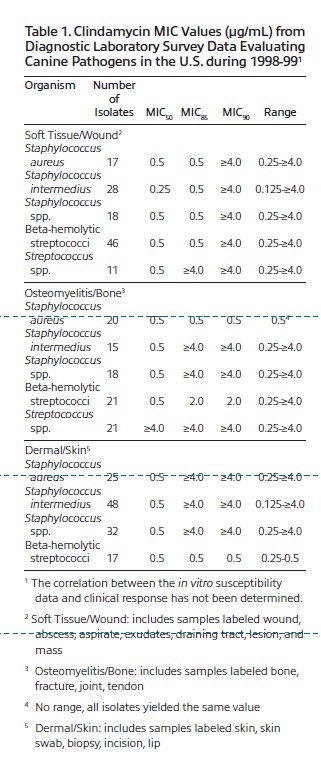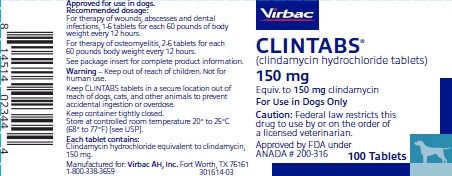CLINTABS (clindamycin hydrochloride 150 mg) Dailymed
Generic: clindamycin hydrochloride is used for the treatment of Acne Vulgaris Actinomycetales Infections Bacteroides Infections Endocarditis, Bacterial Enterocolitis, Pseudomembranous Pneumonia, Pneumocystis Staphylococcal Infections Streptococcal Infections Toxoplasmosis Vaginosis, Bacterial Liver Failure
IMPRINT: C150
SHAPE: round
COLOR: white
All Imprints
clintabs clindamycin 25 mg - c 25 round white
clintabs clindamycin 75 mg - c 75 round white
Go PRO for all pill images
Caution:
Federal law restricts this drug to use by or on the order of a licensed veterinarian.
Description
Clintabs tablets contain clindamycin hydrochloride which is the hydrated salt of clindamycin. Clindamycin is a semisyntheic antibiotic produced by a 7(S)-chlorosubstitution of the 7(R)-hydroxyl group of a naturally produced antibiotic produced by Streptomyces lincolnensis var. lincolnensis.
CLINTABS tablets (For Use in Dogs Only):
25 mg Tablet, each white bisected tablet is marked "C" above the bisect and "25" below the bisect and contains clindamycin hydrochloride equivalent to 25 mg of clindamycin.
75 mg Tablet, each white bisected tablet is marked "C" above the bisect and "75" below the bisect and contains clindamycin hydrochloride equivalent to 75 mg of clindamycin.
150 mg Tablet, each white tablet is marked "C 150" on one side and contains clindamycin hydrochloride equivalent to 150 mg of clindamycin.
Clinical Pharmacology
Absorption: Clindamycin hydrochloride is rapidly absorbed from the canine gastrointestinal tract.
Dog Serum Levels: Serum levels at or above 0.5 Ī¼g/mL can be maintained by oral dosing at a rate of 2.5 mg/lb of clindamycin hydrochloride every 12 hours. This same study revealed that average peak serum concentrations of clindamycin occur 1 hour and 15 minutes after oral dosing. The elimination half-life for clindamycin in dog serum was approximately 5 hours. There was no bioactivity accumulation after a regimen of multiple oral doses in healthy dogs.

Metabolism and Excretion: Extensive studies of the metabolism and excretion of clindamycin hydrochloride administered orally in animals and humans have shown that unchanged drug and bioactive and bioinactive metabolites are excreted in urine and feces. Almost all of the bioactivity detected in serum after clindamycin hydrochloride administration is due to the parent molecule (clindamycin). Urine bioactivity, however, reflects a mixture of clindamycin and active metabolites, especially N-demethyl clindamycin and clindamycin sulfoxide.
Site and Mode of Action: Clindamycin is an inhibitor of protein synthesis in the bacterial cell. The site of binding appears to be in the 50S sub-unit of the ribosome. Binding occurs to the soluble RNA fraction of certain ribosomes, thereby inhibiting the binding of amino acids to those ribosomes. Clindamycin differs from cell wall inhibitors in that it causes irreversible modification of the protein-synthesizing subcellular elements at the ribosomal level.
Microbiology: Clindamycin is a lincosaminide antimicrobial agent with activity against a wide variety of aerobic and anaerobic bacterial pathogens. Clindamycin is a bacteriostatic compound that inhibits bacterial protein synthesis by binding to the 50S ribosomal sub-unit. The minimum inhibitory concentrations (MICs) of Gram-positive and obligate anaerobic pathogens isolated from dogs in the United States are presented in Table 1. Bacteria were isolated in 1998-1999. All MICs were performed in accordance with the Clinical and Laboratory Standards Institute (CLSI).

Indications
CLINTABSĀ® (clindamycin hydrochloride tablets) (for use in dogs only) are indicated for the treatment of infections caused by susceptible strains of the designated microorganisms in the specific conditions uled below:
Dogs: Skin infections (wounds and abscesses) due to coagulase positive staphylococci (Staphylococcus aureus or Staphylococcus intermedius). Deep wounds and abscessesĀ due to Bacteroides fragilis, Prevotella melaninogenicus, Fusobacterium necrophorum and Clostridium perfringens.
Dental infections due to Staphyloccus aureus, Bacteroides fragilis, Prevotella melaninogenicus, Fusobacterium necrophorum and Clostridium perfringens. Osteomyelitis due to Staphylococcus aureus, Bacteroides fragilis, Prevotella melaninogenicus, Fusobacterium necrophorum and Clostridium perfringens.
Contraindications
CLINTABS tablets are contraindicated in animals with a history of hypersensitivity to preparations containing clindamycin or lincomycin.Because of potential adverse gastrointestinal effects, do not administer to rabbits, hamsters, guinea pigs, horses, chinchillas or ruminating animals.
Warnings
Keep out of reach of children. Not for human use.Keep CLINTABS tablets in a secure location out of reach of dogs, cats, and other animals to prevent accidental ingestion or overdose.
Precautions
During prolonged therapy of one month or greater, periodic liver and kidney function tests and blood counts should be performed.The use of clindamycin hydrochloride occasionally results in overgrowth of non-susceptible organisms such as clostridia and yeasts. Therefore, the administration of CLINTABS tablets should be avoided in those species sensitive to the gastrointestinal effects of clindamycin (see CONTRAINDICATIONS). Should superinfections occur, appropriate measures should be taken as indicated by the clinical situation.
Patients with very severe renal disease and/or very severe hepatic disease accompanied by severe metabolic aberrations should be dosed with caution, and serum clindamycin levels monitored during high-dose therapy.
Clindamycin hydrochloride has been shown to have neuromuscular blocking properties that may enhance the action of other neuromuscular blocking agents. Therefore, CLINTABS tablets should be used with caution in animals receiving such agents.
Safety in gestating bitches or breeding male dogs has not been established.
Adverse Reactions
Side effects occasionally observed in either clinical trials or during clinical use were vomiting and diarrhea.To report adverse reactions or a suspected adverse reaction, call 1-800-338-3659.
Dosage And Administration
Dogs:
Infected Wounds, Abscesses, and Dental Infections Oral: 2.5-15.0 mg/lb body weight every 12 hours. Duration: Treatment with clindamycin hydrochloride products may be continued up to a maximum of 28 days if clinical judgment indicates. Treatment of acute infections should not be continued for more than three or four days if no response to therapy is seen.
Dosage Schedule: Tablets CLINTABS 25 mg, administer 1-6 tablets every 12 hours for each 10 pounds of body weight. CLINTABS 75 mg, administer 1-6 tablets every 12 hours for each 30 pounds of body weight. CLINTABS 150 mg, administer 1-6 tablets every 12 hours for each 60 pounds of body weight.
Dogs: Osteomyelitis Oral: 5.0-15.0 mg/lb body weight every 12 hours. Duration: Treatment with clindamycin hydrochloride is recommended for a minimum of 28 days. Treatment should not be continued for longer than 28 days if no response to therapy is seen.
Dosage Schedule: Tablets CLINTABS 25 mg, administer 2-6 tablets every 12 hours for each 10 pounds of body weight. CLINTABS 75 mg, administer 2-6 tablets every 12 hours for each 30 pounds of body weight. CLINTABS 150 mg, administer 2-6 tablets every 12 hours for each 60 pounds of body weight.
Animal Safety Summary
Rat and Dog Data: One year oral toxicity studies in rats and dogs at doses of 30, 100 and 300 mg/kg/day (13.6, 45.5 and 136.4 mg/lb/day) have shown clindamycin hydrochloride capsules to be well tolerated. Differences did not occur in the parameters evaluated to assess toxicity when comparing groups of treated animals with contemporary controls. Rats administered clindamycin hydrochloride at 600 mg/kg/day (272.7 mg/lb/day) for six months tolerated the drug well; however, dogs orally dosed at 600 mg/kg/day (272.7 mg/lb/day) vomited, had anorexia, and subsequently lost weight. At necropsy these dogs had erosive gastritis and focal areas of necrosis of the mucosa of the gall bladder.
Safety in gestating bitches or breeding males has not been established.
Storage
Store at controlled room temperature 20Ė to 25Ė C (68Ė to 77Ė F) [see USP].
How Supplied
CLINTABS tablets are available as:25 mg - bottles of 40075 mg - bottles of 200150 mg - bottles of 100
Approved by FDA under ANADA # 200-316
To report suspected adverse drug events,for technical assistance or to obtain a copy of the Safety Data Sheet (SDS), contact Virbac AH, Inc. at 1-800-338-3659 or us.virbac.com. For additional information about adverse drug experience reporting for animalĀ drugs, contact FDA at 1-888-FDA-VETS or http://www.fda.gov/reportanimalae.
Manufactured for: Virbac AH, Inc.P.O. Box 162059Fort Worth, TX 76161, USA1-800-338-3659
Revised: February 2023 301617-06Ā© 2023 Virbac Corporation. All rights reserved.CLINTABS is a registered trademark of Virbac AH, Inc.
Clintabs 25 Mg
Clintabs 75 Mg
Clintabs 150 Mg
DISCLAIMER:
"This tool does not provide medical advice, and is for informational and educational purposes only, and is not a substitute for professional medical advice, treatment or diagnosis. Call your doctor to receive medical advice. If you think you may have a medical emergency, please dial 911."
"Do not rely on openFDA to make decisions regarding medical care. While we make every effort to ensure that data is accurate, you should assume all results are unvalidated. We may limit or otherwise restrict your access to the API in line with our Terms of Service."
"This product uses publicly available data from the U.S. National Library of Medicine (NLM), National Institutes of Health, Department of Health and Human Services; NLM is not responsible for the product and does not endorse or recommend this or any other product."
PillSync may earn a commission via links on our site





